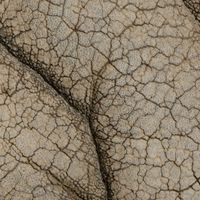ABOVE: A close-up view of elephant skin reveals both larger-scale wrinkles (dark, shadowy crevices) and microscale cracks (branched lines in between wrinkles).
© UNIGE (UNIVERSITY OF GENEVA), LIANA MANUKYAN
Not only does African bush elephant (Loxodonta africana) skin looked cracked from a distance—it looks the same way up close, and even under the microscope. That’s because in addition to the giant mammal’s macroscale wrinkles, it has micrometer-scale fractures in its epidermis that result from mechanical stress of the tissue’s growth, according to a study published last week (October 2) in Nature Communications.
Specifically, as the stratum corneum, the outermost layer of skin, thickens, bending stress causes the formation of interconnected channels. These structures retain five to ten times more water than a flat surface and help protect the animals from parasites, while improving their ability to regulate their body temperature.
A.F. Martins et al., “Locally-curved geometry...
Interested in reading more?







